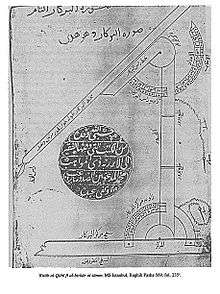Abū Ja'far al-Khāzin
Abu Jafar Muhammad ibn Hasan Khazini (900–971), also called Al-Khazin, was an Iranian[1] Muslim astronomer and mathematician from Khorasan. He worked on both astronomy and number theory.
Al-Khazin was one of the scientists brought to the court in Ray, Iran by the ruler of the Buyid dynasty, Adhad ad-Dowleh, who ruled from 949 to 983 AD. In 959/960 Khazini was required by the Vizier of Ray, who was appointed by ad-Dowleh, to measure the obliquity of the ecliptic.
One of Al-Khazin's works Zij al-Safa'ih ("Tables of the disks of the astrolabe") was described by his successors as the best work in the field and they make many references to it. The work describes some astronomical instruments, in particular an astrolabe fitted with plates inscribed with tables and a commentary on the use of these. A copy of this instrument was made, but it vanished in Germany at the time of World War II. A photograph of this copy was taken and examined in D.A. King's New light on the Zij al-Safa'ih of Abu Ja'far al-Khazin, Centaurus 23 (2) (1979/80), 105-117.
Al-Khazin also wrote a commentary on Ptolemy's Almagest in which he gives nineteen propositions relating to statements by Ptolemy. He proposed a different solar model from Ptolemy's.
References
- ↑ Selin, Helaine (2008). Encyclopaedia of the history of science, technology, and medicine in non-western cultures. Berlin New York: Springer. p. 275. ISBN 9781402049606.
A newly discovered manuscript (not yet available for research) contains a treatise by the tenth century Iranian astronomer Abū Ja˓far al-Khāzin describing an equatorium called Zīj al-Safāīh. (the Zīj of Plates).
- O'Connor, John J.; Robertson, Edmund F., "Abu Jafar Muhammad ibn al-Hasan Al-Khwarizmi", MacTutor History of Mathematics archive, University of St Andrews.
- Rashed, Roshdi (1996). Les Mathématiques Infinitésimales du IXe au XIe Siècle 1: Fondateurs et commentateurs: Banū Mūsā, Ibn Qurra, Ibn Sīnān, al-Khāzin, al-Qūhī, Ibn al-Samḥ, Ibn Hūd. London. Reviews: Seyyed Hossein Nasr (1998) in Isis 89 (1) pp. 112-113; Charles Burnett (1998) in Bulletin of the School of Oriental and African Studies, University of London 61 (2) p. 406.
External links
- Calvo, Emilia (2007). "Khāzin: Abū Jaʿfar Muḥammad ibn al‐Ḥusayn al‐Khāzin al‐Khurāsānī". In Thomas Hockey; et al. The Biographical Encyclopedia of Astronomers. New York: Springer. pp. 628–9. ISBN 978-0-387-31022-0. (PDF version)
- Dold-Samplonius, Yvonne (2008) [1970–1980]. "Al-Khāzin, Abū Ja'far Muḥammad Ibn Al-Ḥasan Al-Khurāsānī". Complete Dictionary of Scientific Biography. Encyclopedia.com.
